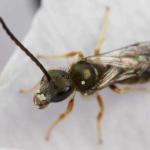?Apis crocipes FOURCROY 1785; Apis flavipes (FABRICIUS 1787) (nec A. flavipes FUESSLIN 1775); Halictus fasciatus NYLANDER 1848 (nec auctorum); Halictus tumulorum var deviridatus STRAND 1910; Halictus ferripennis COCKERELL 1929
A rather small, metallic green bee, with white tomentose hair bands on the gaster. The relationship with H. confusus is close and great care must be taken, particularly with females, when identifying specimens collected in southern Britain. May only be reliably determined from the male, which should always be dissected to show the vital character in the genitalia.
A widespread species, from southern Britain north to the Central Highlands of Scotland. Also found in the Isles of Scilly and the Channel Islands. Widespread and common in the Palaearctic region.
This species is not regarded as being scarce or threatened.
Found commonly on sandy and calcareous soils but scarcer on heavy clay. Prefers open habitat.
Females are found from mid-March to October, with males appearing in late June or early July.
This mining bee is thought to be primitively eusocial; early accounts of a solitary life cycle are now considered incorrect. Nests are excavated in horizontal ground which is usually sparsely vegetated or with a short sward. The burrow is vertical or nearly so, occasionally branched, with sessile cells opening off the main shaft of the nest. The foundress female constructs 6-9 horizontal cells off a short tunnel in the spring, of which 2 or 3 may produce males, the remainder producing workers. Many of these workers mate but do not undergo ovarian development. The second brood produces males and females which mate and then the latter hibernate. There are accounts of foundresses hibernating for a second winter.
A wide range of flowers are visited for nectar.
No Sphecodes are host specific on this bee.
Updated: January 2012


